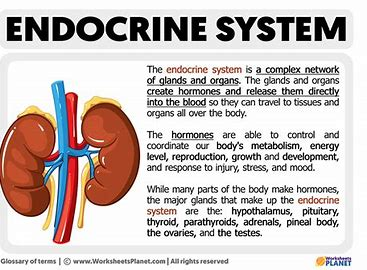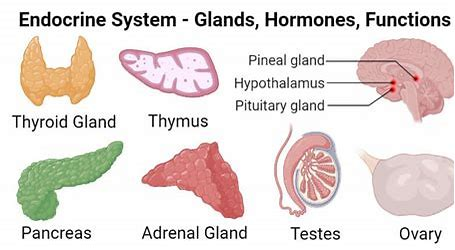Endocrine System Flashcards

Endocrine vs. Exocrine

Endocrine Glands
Ductless glands that secrete hormones directly into the bloodstream.
Hormones are secreted into the blood and act as chemical messengers produced by the gland.
Richly supplied with capillaries for hormone entry into the bloodstream.
Examples include the pituitary gland, thyroid gland, adrenal glands, and parts of the pancreas and ovaries/testes
Hormones travel throughout the body to reach target cells that possess specific receptors, ensuring that only the cells meant to respond do so.
Exocrine Glands
Secrete their products into ducts that lead to the external environment, rather than directly into the bloodstream. Examples include sweat glands, salivary glands, and glands in the gastrointestinal tract.
Possess ducts through which chemical secretions are transported to specific locations, such as the skin surface or digestive tract.
Examples include sweat glands, salivary glands, mammary glands, and digestive glands in the stomach and intestines.
Terminology
Hormones: Organic chemical substances secreted by an endocrine gland, transported in the bloodstream to a target organ to regulate metabolic reactions.
Divided into two main classes: amino acid-based hormones (proteins and peptides) and steroid hormones (derived from cholesterol).
Amino acid-based hormones usually bind to receptors on the cell membrane, activating a signaling cascade inside the cell.
Steroid hormones can pass through the cell membrane and bind to receptors inside the cell, often affecting gene expression directly.
Target Organ: Cells that respond to a hormone with receptor sites.
Target cells have specific receptors that match the hormone's structure, ensuring a specific response.
The number of receptors on a target cell can change, affecting sensitivity to a hormone.
Endocrine Gland: Vascular, ductless gland that secretes hormones directly into the bloodstream.
Highly vascularized to ensure hormones can quickly enter the circulation.
Hormone secretion is often regulated by feedback loops to maintain homeostasis.
Endocrine System - Male & Female
Key Glands and Organs:
Pineal gland: Secretes melatonin, which regulates sleep-wake cycles.
Hypothalamus: Controls the pituitary gland and regulates body temperature, hunger, and thirst.
Pituitary Gland: Often referred to as the \"Master Gland,\" it controls other endocrine glands.
Thyroid: Produces hormones that regulate metabolism.
Parathyroid: Regulates calcium levels in the blood.
Thymus: Important for immune function, especially during childhood.
Adrenal Cortex: Produces hormones like cortisol and aldosterone.
Kidney: Produces erythropoietin, which stimulates red blood cell production.
Pancreas: Secretes insulin and glucagon to regulate blood sugar levels.
Testes (Male): Produce testosterone, which is crucial for male sexual development and function.
Ovary (Female): Produces estrogen and progesterone, essential for female sexual development, menstruation, and pregnancy.
Uterus (Female): Supports fetal development during pregnancy.
Each gland and organ plays a vital role in maintaining hormonal balance, affecting various bodily functions.
Pituitary Gland
Often referred to as the "Master Gland."
Size of a pea and located at the base of the brain within the sella turcica.
Connected to the hypothalamus by the pituitary stalk.
Posterior Lobe:
Stores and secretes hormones produced by the hypothalamus: ADH (Anti-Diuretic Hormone) and oxytocin.
Secretes ADH (Anti-Diuretic Hormone).
Also known as vasopressin, regulates water balance by increasing water reabsorption in the kidneys.
Deficiency can cause diabetes insipidus, characterized by excessive thirst and urination.
Secretes Oxytocin.
Stimulates uterine contractions during childbirth and milk ejection during breastfeeding.
Also involved in social bonding and trust.
Anterior Lobe:
Produces and secretes several key hormones, each affecting different target organs.
Secretes GH (Growth Hormone).
Promotes growth and development of bones and muscles.
Stimulates protein synthesis and fat breakdown.
Regulated by growth hormone-releasing hormone (GHRH) and somatostatin.
Secretes TSH (Thyroid Stimulating Hormone).
Stimulates the thyroid gland to produce thyroxine (T4) and triiodothyronine (T3).
These hormones regulate metabolism, body temperature, and energy levels.
Controlled by thyrotropin-releasing hormone (TRH) from the hypothalamus.
Secretes FSH (Follicle-Stimulating Hormone).
In females, promotes follicle development in the ovaries; in males, stimulates sperm production.
Essential for reproductive function in both sexes.
Secretes LH (Luteinizing Hormone).
In females, triggers ovulation and formation of the corpus luteum; in males, stimulates testosterone production.
Works in conjunction with FSH to regulate the menstrual cycle and spermatogenesis.
Secretes Prolactin.
Stimulates milk production in mammary glands after childbirth.
Can be affected by certain medications and medical conditions.
The pituitary gland's function is critical for overall endocrine regulation.
Disorders
Hyper-: Indicates over-secretion of a hormone.
Can be caused by tumors or autoimmune disorders, leading to excessive hormone levels and related symptoms.
Hypo-: Indicates under-secretion of a hormone.
Can be caused by gland damage, genetic factors, or other medical conditions, leading to hormone deficiencies and related symptoms.
Growth Hormone (GH) Disorders:
Gigantism: Excessive growth due to over-secretion of GH.
Typically begins in childhood or adolescence, leading to significantly increased height and bone growth.
Dwarfism: Stunted growth due to under-secretion of GH.
Can be treated with GH injections if diagnosed early, improving growth and development.
Acromegaly: Abnormal growth of hands, feet, and face, caused by over-secretion of GH in adults.
Often associated with a pituitary tumor, leading to gradual changes in physical appearance and potential health complications.
Thyroid Gland & Thyroxin Disorders
Hyperthyroidism: Overactive thyroid, excessive thyroxin secretion.
Symptoms include weight loss, increased heart rate, anxiety, and heat intolerance.
Hypothyroidism: Underactive thyroid, insufficient thyroxin secretion.
Symptoms include weight gain, fatigue, depression, and cold intolerance.
Myxoedema: Type of hypothyroidism in adults
Characterized by swelling of the skin and tissues, along with other symptoms like lethargy and cognitive impairment.
Cretinism: Congenital hypothyroidism.
Can lead to developmental delays if not treated early; early diagnosis and treatment are critical for normal development.
Pancreas
Functions as both an endocrine and exocrine gland.
Alpha cells secrete Glucagon.
Raises blood glucose levels by stimulating the liver to break down glycogen into glucose.
Beta cells secrete Insulin.
Lowers blood glucose levels by facilitating glucose uptake into cells and converting glucose into glycogen in the liver.
Diabetes: A disorder related to the pancreas, specifically with insulin production or utilization.
Type 1: Insulin-dependent, typically diagnosed in childhood; the body does not produce insulin.
Type 2: Insulin resistance, often associated with obesity and lifestyle factors; the body does not respond effectively to insulin.
Understanding these disorders is crucial for proper diagnosis and management.
Adrenal Gland
Located on top of the kidneys
Consists of two main parts: the adrenal cortex and the adrenal medulla.
Secretes:
Adrenalin (Epinephrine).
Involved in the "fight or flight" response, increasing heart rate, blood pressure, and energy levels during stress.
Aldosterone.
Regulates sodium and potassium levels, helping to maintain fluid balance and blood pressure.
Cortisol: Regulates metabolism, immune response, and stress response.
Ovaries
Responsible for producing Estrogen and Progesterone.
Estrogen
Steroid hormone important in the reproductive development of females.
Produced by the growing Grafian follicle in the ovaries.
Secreted by ovaries prior to ovulation; also produced by the placenta during pregnancy.
Secretion is regulated by FSH, which stimulates follicle growth and estrogen production.
Involved in the formation and maintenance of secondary sex characteristics; also important in bone resorption and cardiovascular health.
Involved in the enlargement of the uterus and breasts during pregnancy, preparing the body for childbirth and lactation.
Progesterone
Steroid hormone that prepares the uterus for pregnancy and supports the early stages of pregnancy.
Produced by the corpus luteum after ovulation.
Secreted by the ovaries after ovulation; also produced by the placenta during pregnancy.
Secretion is regulated by LH, which stimulates the formation and maintenance of the corpus luteum.
Involved in the formation and maintenance of endometrium and uterus, creating a suitable environment for implantation and fetal development.
Involved in the reduction of contractility of the uterus and stimulates the growth of mammary glands, ensuring the uterus remains relaxed and the breasts develop for milk production.
Menstruation Cycle:
Phases include follicular phase, ovulation, and luteal phase, each associated with varying levels of estrogen and progesterone.
Hormonal fluctuations throughout the cycle regulate endometrial changes, preparing the uterus for potential pregnancy.
The interplay between estrogen and progesterone is essential for female reproductive health.
Testes
Produces Testosterone, the primary male sex hormone.
Negative Feedback Loop: Regulates Testosterone Production
Stimulus: Testosterone levels get too low.
Hypothalamus: Releases gonadotropin releasing hormone (GnRH), which stimulates the pituitary gland.
Pituitary gland: Releases Luteinizing Hormone (LH) and Follicle Stimulating Hormone (FSH), which act on the testes.
Testes: Stimulated by LH and FSH to produce testosterone and Inhibin B.
Increased levels of testosterone and inhibin B in the blood: Negative feedback to hypothalamus and pituitary to stop GnRH, LH, and FSH release, maintaining hormonal balance.
Testosterone is crucial for the development and maintenance of male secondary sex characteristics and muscle mass.
Homeostasis
All body cells are surrounded by fluids, such as interstitial fluid and plasma.
The composition of these fluids changes constantly, influencing cell function; maintaining a stable internal environment is critical for cell survival.
Maintaining a constant internal environment in the body irrespective of the external environment; this dynamic equilibrium ensures optimal conditions for cellular function.
Conditions that must be kept constant for optimal functioning:
Glucose levels: Essential for energy production.
Water content: Necessary for cellular processes and hydration.
Salt concentration: Crucial for nerve function and fluid balance.
O2 and CO2 concentrations: Necessary for respiration and pH balance.
Body temperature: Important for enzyme function and metabolic rate.
Metabolic waste: Removal prevents toxicity and maintains cell health.
pH: Essential for enzyme activity and cellular function.
Negative Feedback Mechanism (NFM)
Mechanisms are in place to bring any deviations back to normal, ensuring conditions stay within optimal ranges.
NFM are responsible for maintaining homeostasis; they are essential for survival.
When a deviation is detected, it results in a reaction that counters the change to return to normal; this corrective response helps to stabilize the internal environment.
Once it is back to normal, the corrective measure is switched off, preventing overcorrection.
Components: Receptor (sensor), Control Center, Effector.
Stimulus $\rightarrow$ Change Detected $\rightarrow$ Information Sent to Control Center $\rightarrow$ Information Sent to Effector $\rightarrow$ Response to Return to Homeostasis
The NFM is a fundamental process in maintaining physiological stability.
Blood Glucose Levels
When blood sugar is too high:
Beta cells detect the raised glucose levels, releasing insulin.
Insulin goes to liver and muscles, promoting glucose uptake.
Glucose is converted to glycogen and stored in the liver and muscles.
Cell membranes become more permeable to glucose, facilitating glucose entry into cells.
Glucose levels are reduced, restoring normal blood sugar levels.
When blood glucose level is too low:
Alpha cells detect the decreased glucose levels, releasing glucagon.
Glucagon goes to liver, stimulating glycogen breakdown.
Glycogen is broken down into glucose, releasing glucose into the bloodstream.
Glucose levels are increased, restoring normal blood sugar levels.
Maintaining proper blood glucose levels is vital for energy balance and preventing complications such as diabetes.
Male Reproductive Hormones
When testosterone is too low:
The pituitary gland will be stimulated to release more FSH and LH.
More testosterone will be released by the testes.
This causes spermatogenesis to occur, increasing sperm production.
More sperm is being produced, ensuring